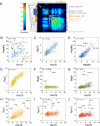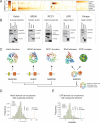A quantitative chaperone interaction network reveals the architecture of cellular protein homeostasis pathways
- PMID: 25036637
- PMCID: PMC4104544
- DOI: 10.1016/j.cell.2014.05.039
A quantitative chaperone interaction network reveals the architecture of cellular protein homeostasis pathways
Abstract
Chaperones are abundant cellular proteins that promote the folding and function of their substrate proteins (clients). In vivo, chaperones also associate with a large and diverse set of cofactors (cochaperones) that regulate their specificity and function. However, how these cochaperones regulate protein folding and whether they have chaperone-independent biological functions is largely unknown. We combined mass spectrometry and quantitative high-throughput LUMIER assays to systematically characterize the chaperone-cochaperone-client interaction network in human cells. We uncover hundreds of chaperone clients, delineate their participation in specific cochaperone complexes, and establish a surprisingly distinct network of protein-protein interactions for cochaperones. As a salient example of the power of such analysis, we establish that NUDC family cochaperones specifically associate with structurally related but evolutionarily distinct β-propeller folds. We provide a framework for deciphering the proteostasis network and its regulation in development and disease and expand the use of chaperones as sensors for drug-target engagement.
Copyright © 2014 Elsevier Inc. All rights reserved.
Figures







Similar articles
-
Specific Binding of Tetratricopeptide Repeat Proteins to Heat Shock Protein 70 (Hsp70) and Heat Shock Protein 90 (Hsp90) Is Regulated by Affinity and Phosphorylation.Biochemistry. 2015 Dec 8;54(48):7120-31. doi: 10.1021/acs.biochem.5b00801. Epub 2015 Nov 25. Biochemistry. 2015. PMID: 26565746 Free PMC article.
-
Interplay between the Hsp90 Chaperone and the HslVU Protease To Regulate the Level of an Essential Protein in Shewanella oneidensis.mBio. 2019 May 14;10(3):e00269-19. doi: 10.1128/mBio.00269-19. mBio. 2019. PMID: 31088919 Free PMC article.
-
The Hsp70-Hsp90 Chaperone Cascade in Protein Folding.Trends Cell Biol. 2019 Feb;29(2):164-177. doi: 10.1016/j.tcb.2018.10.004. Epub 2018 Nov 28. Trends Cell Biol. 2019. PMID: 30502916 Review.
-
Evolution and function of diverse Hsp90 homologs and cochaperone proteins.Biochim Biophys Acta. 2012 Mar;1823(3):607-13. doi: 10.1016/j.bbamcr.2011.09.020. Epub 2011 Oct 8. Biochim Biophys Acta. 2012. PMID: 22008467 Review.
-
Interaction of the Hsp90 cochaperone cyclophilin 40 with Hsc70.Cell Stress Chaperones. 2004 Summer;9(2):167-81. doi: 10.1379/csc-26r.1. Cell Stress Chaperones. 2004. PMID: 15497503 Free PMC article.
Cited by
-
Fluorescence ImmunoPrecipitation (FLIP): a Novel Assay for High-Throughput IP.Biol Proced Online. 2016 Aug 15;18:16. doi: 10.1186/s12575-016-0046-x. eCollection 2016. Biol Proced Online. 2016. PMID: 27528826 Free PMC article.
-
Myotubularin-related proteins 3 and 4 interact with polo-like kinase 1 and centrosomal protein of 55 kDa to ensure proper abscission.Mol Cell Proteomics. 2015 Apr;14(4):946-60. doi: 10.1074/mcp.M114.046086. Epub 2015 Feb 6. Mol Cell Proteomics. 2015. PMID: 25659891 Free PMC article.
-
Stress-induced p53 drives BAG5 cochaperone expression to control α-synuclein aggregation in Parkinson's disease.Aging (Albany NY). 2020 Oct 21;12(20):20702-20727. doi: 10.18632/aging.103998. Epub 2020 Oct 21. Aging (Albany NY). 2020. PMID: 33085644 Free PMC article.
-
Identifying and Validating MYC:Protein Interactors in Pursuit of Novel Anti-MYC Therapies.Methods Mol Biol. 2021;2318:45-67. doi: 10.1007/978-1-0716-1476-1_4. Methods Mol Biol. 2021. PMID: 34019286
-
Proteotoxicity and cardiac dysfunction.Circ Res. 2015 May 22;116(11):1863-82. doi: 10.1161/CIRCRESAHA.116.305372. Circ Res. 2015. PMID: 25999425 Free PMC article. Review.
References
-
- Barrios-Rodiles M, Brown KR, Ozdamar B, Bose R, Liu Z, Donovan RS, Shinjo F, Liu Y, Dembowy J, Taylor IW, et al. High-throughput mapping of a dynamic signaling network in mammalian cells. Science. 2005;307:1621–1625. - PubMed
-
- Briknarová K, Takayama S, Homma S, Baker K, Cabezas E, Hoyt DW, Li Z, Satterthwait AC, Ely KR. BAG4/SODD protein contains a short BAG domain. J Biol Chem. 2002;277:31172–31178. - PubMed
Publication types
MeSH terms
Substances
Grants and funding
LinkOut - more resources
Full Text Sources
Other Literature Sources
Molecular Biology Databases
Research Materials

